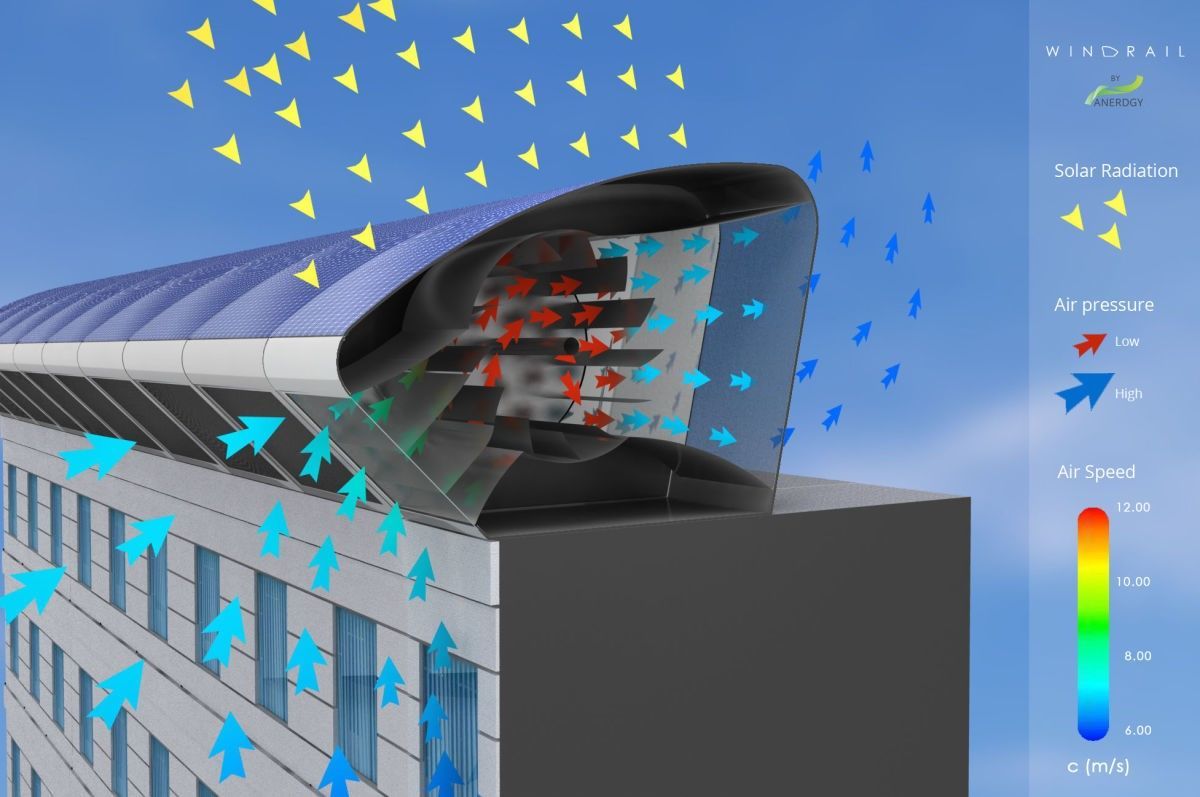Building-integrated wind turbine technology has been receiving a lot of heat for not being able to deliver what it promises in terms of energy production.
Fast Co. Exist profiles a system that places the turbines where they can actually turn. The WindRail was designed in Zurich, Switzerland, where there isn’t enough space for a wind or solar park. Sitting between a building’s façade and the roof edge, the system combines wind and solar energy harvesting, taking advantage of the building’s air flows, even if it's in the middle of a city.
The system was developed by the Anerdgy. “When wind flows around the building, it creates a pressure difference between the façade and the rooftop. The façade has a higher wind pressure,” CEO of Anerdgy Sven Koehler told Fast Co. Exist. “Because we are channeling the wind and making a connection between the high and low pressure areas, the speeds are faster and we have more energy.”
Koehler, an engineer and economist, came up with the idea with the help of his parents. After years of research, he came up with the WindRail System and started the company in 2012.
According to the company, pressure effect accounts for 50% of the power the WindRail generates. The device comes in two meter modules and can generate 1,500 to 2,000 kWh a year. For comparison, the average U.S. home uses 10,837 kWh a year, Fast Co. Exist reports.


Related Stories
| May 28, 2013
LED lighting's risks and rewards
LED lighting technology provides unique advantages, but it’s also important to understand its limitations for optimized application.
| May 17, 2013
5 things AEC pros need to know about low-e glass
Low-emissivity glasses are critical to making today’s buildings brighter, more energy-efficient, and more sustainable. Here are five tips to help AEC professionals understand the differences among low-e glasses and their impact on building performance.
| May 16, 2013
Lilker acquires DC-based EMO Energy Solutions
Lilker Associates Consulting Engineers (lilker.com), a multidisciplinary MEP engineering firm with offices in Manhattan and Long Island, announces the acquisition of EMO Energy Solutions (EMO), a Falls Church, VA-based company in the DC Metro area specializing in energy audits, energy modeling, commissioning and LEED® consultation services.
| May 15, 2013
Schneider Electric announces Global Xperience Efficiency Events for 2013
Schneider Electric’s Xperience Efficiency series will begin with events in the United States, China, Colombia, Brazil and Russia.
| May 14, 2013
Advanced turbines generate 6X more energy than conventional models
US-based wind energy company SheerWind just unveiled the INVELOX – a tunnel-based wind turbine that can produce up to 600% more power than traditional wind turbines.
| May 4, 2013
Research program offers incentives to homes, businesses toward new propane-fueled products
Propane Heat & Power Incentive Program provides up to $10,000 for qualifying generators, micro-CHP systems
| May 3, 2013
'LEED for all GSA buildings,' says GSA Green Building Advisory Committee
The Green Building Advisory Committee established by the General Services Administration, officially recommended to GSA that the LEED green building certification system be used for all GSA buildings as the best measure of building efficiency.
| Apr 16, 2013
5 projects that profited from insulated metal panels
From an orchid-shaped visitor center to California’s largest public works project, each of these projects benefited from IMP technology.
| Apr 10, 2013
23 things you need to know about charter schools
Charter schools are growing like Topsy. But don’t jump on board unless you know what you’re getting into.
| Apr 1, 2013
Half of building owners use 'smart' technologies, says survey
A survey of 291 building owners by IDC Energy Insights shows that 50% of owners use smart building technologies, such as HVAC controls, lighting controls, and analytics/data management.

















